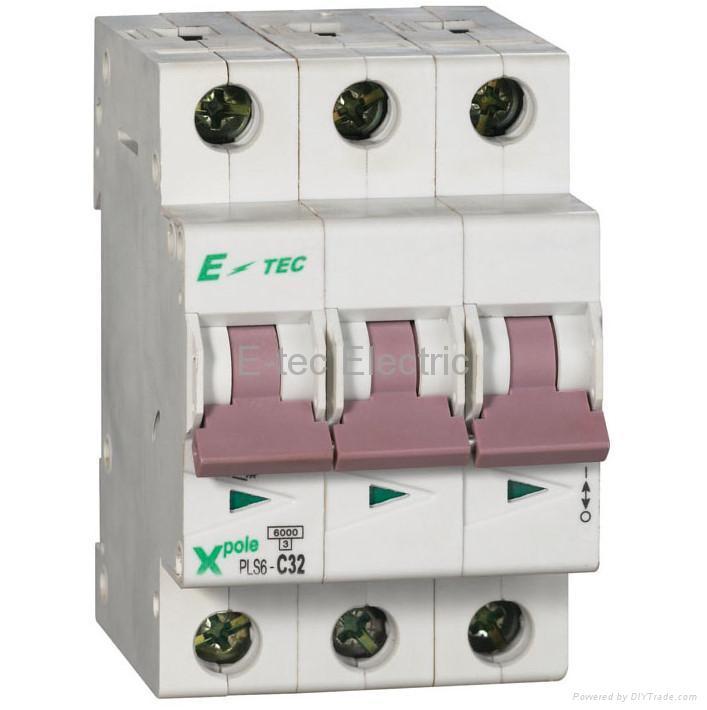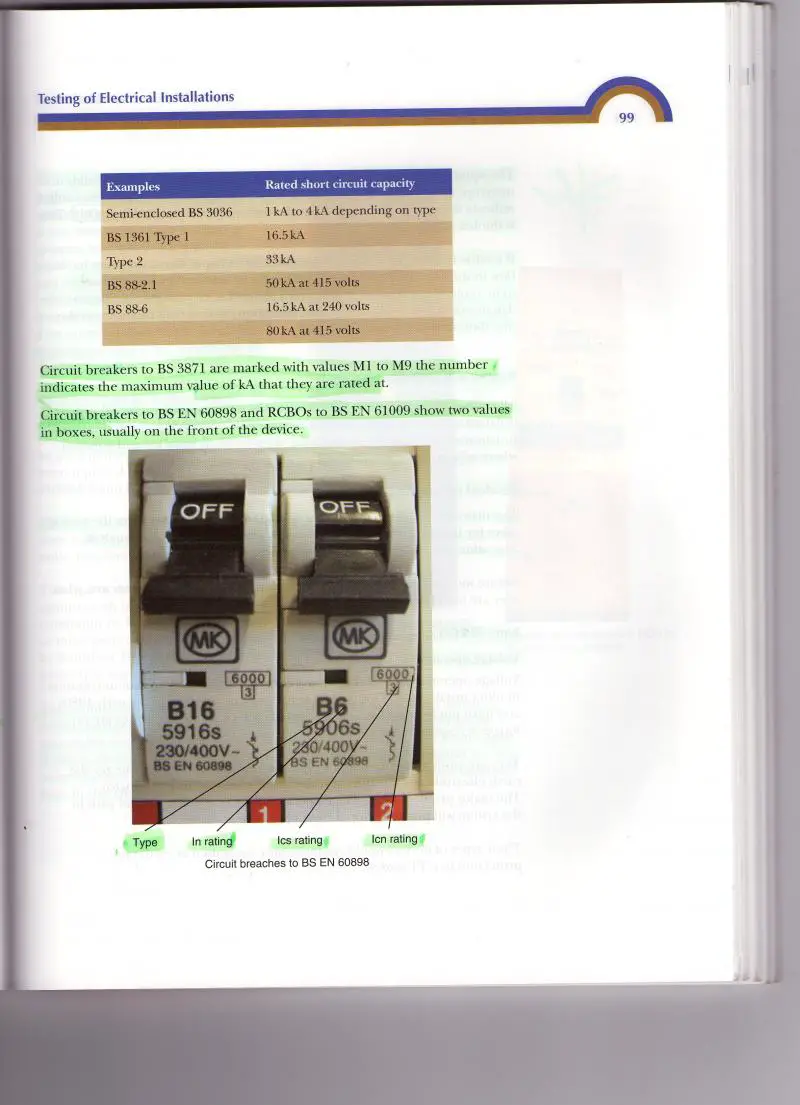How would you know what current had flowed, and therefore how well done the innards of your MCB were?
You are using an out of date browser. It may not display this or other websites correctly.
You should upgrade or use an alternative browser.
You should upgrade or use an alternative browser.
Prospective fault current
- Thread starter Jacobssi
- Start date
How would you know what current had flowed, and therefore how well done the innards of your MCB were?
Ha Ha, I did actually ask that question during the 2391 and I never got an answer either - I guess, if it still works, it works, and if it doesn't, it doesn't
P
PrinceofDarkness
I suppose the O/P as a 'learner', will find the above definitions/explanations useful. But having a simplified definition is no substitute for learning (and understanding) the actual definition - as issued by the Supply Industry - and more importantly: the reason for having such information........
"PSCC: The current that would flow in acircuit, in the event of a short circuit of negligble impedance, if the overcurrrent protective device were replaced by a conductor of negligble impedance; it is measured as the RMS value of the ac component. The actual fault current will therefore be less if the protective device has a current limiting feature or an appreciable impedance".
Lucia.
The purpose of this thread was for the O/P to understand the nature of the PSCC. I've reproduced here the definitiveand only definition given by the people who matter in the supply industry.
The PSCC is a notional figure of the maximum current likely to flow. This necessarily has to be calculated without such limiting devices as sub-circuit MCBs etc .
Very rarely would an actual S/C current of that order occur on an installation, because that fault would most likely be attenuated by the circuit impedance.
It's a theoretical question, and nothing to get fired up about, because the supplier is ulimately responsible for such matters.
Lucia.
What in a simple definition is prospective fault current?
That is the purpose of the thread - not the tripe that you have prattled out
It's a theoretical question, and nothing to get fired up about, because the supplier is ulimately responsible for such matters.
Lucia.
Really - 612.11
The supplier might be responsible for the origin fault current and cutout fuse, but he isn't responsible for the 'other relevant points in the installation' - we are.
If it was theoretical and unimportant, the engineers who write the regs and GN3 and city and guilds with their 2391, wouldn't put that much emphasis on it, would they?
And you still haven't answered my question!!
Now I know you're full of it, Darkness, you're just on a wind-up mission, get a life!
P
PrinceofDarkness
Pardon me, dear, but I've forgotten what your 'question' was......
If it's a serious question, and you can be bothered to repeat it, I'd be pleased to consider whether to reply to it.....
Lucia.
If it's a serious question, and you can be bothered to repeat it, I'd be pleased to consider whether to reply to it.....
Lucia.
If the PSCC was dealt with by the service fuse, why doesn't it blow on a short circuit everytime?
If what you say above is true, then explain one thing - why do they bother printing the two figures on an MCB?? - just for the hell of it??
either one of those I suspect...
- Joined
- 8 Feb 2008
- Messages
- 435
- Reaction score
- 20
- Country

You could have a fault in the CU and blow the service fuse if the current gets high enough for long enough.
It is just more normal to have a fault down the cable a bit which introduces impedance thus limiting the fault current down so only the circuit protective device operates.
I don't think they print the servicable fault current on the MCB, the one in the box is just the maximum.
It is plausable to fit a board with a lower max fault current providing that backup protection is provided.
The full figure e.g. 6000 is in Amps and is the maximum.
The single figure - normally directly below e.g. 3 is in KA and is the serviceable figure.
The single figure in the square window - whoops - I mean box
BS EN 60898-1 2003 + A1 2004.
The figure could be a 1, 2 or 3 - indicating the energy limiting class.
Table ZA1 deals with mcbs up to 16A and table ZA 2 from 16A to 32A. MCBs above this are not included in this classification.
The figures are given for various fault ratings for Types B and C only.
They are maxima and manufactured equipment normally produces much better results.
A typical set of values is:
Class 1 (1 in the box) no limits
Class 2 (2 in the box)
Rated short circuit capacity 10kA
Type B 240000 As
Type C 290000 As
Class 3 (3 in the box) - most are now these
Rated short circuit capacity 10kA
Type B 70000 As
Type C 84000 As
Corresponding lower values are given for Rated short circuit capacities less than 10 kA (3kA, 4.5kA & 6kA).
These values tell you the maximum 'let through energy' that the mcb can allow before operating - so they affect downstream equipment (cables, protective devices etc.)
Manufacturers sometimes quote figures at lower input fault levels - claiming that this is more realistic. That may be, but you need to be aware how their figures have been obtained if you are to make proper use of them.
Be careful not to confuse Energy Limiting Class with Current Limiting - the former can take several cycles to operate, but the latter must operate in less than 1/4 cycle.
With regard to all of the rest of this thread - I would rather stay out of it
Extremely interesting, notohimagain,
I can't dispute what you are saying as I don't know enough about the subject, so I'll take your word for it.
We were informed, (wrongly, it seems), that this was the serviceable breaking capacity figure - and this from a NICEIC assessor.
I can't dispute what you are saying as I don't know enough about the subject, so I'll take your word for it.
We were informed, (wrongly, it seems), that this was the serviceable breaking capacity figure - and this from a NICEIC assessor.
Hmm...I guess, if it still works, it works, and if it doesn't, it doesn't
Define "works".
- Joined
- 8 Feb 2008
- Messages
- 435
- Reaction score
- 20
- Country

The mcb is marked with its Icn rating - that is its Rated Short Circuit Capacity.
The Ics value does not have to be on the mcb - this is its Service Short Circuit Capacity.
For BS EN 60898 MCBs: Ics = Icn * (factor k) Where k is just a number given in this table.
Icn k
<= 6000A 1
> 6000A 0.75 (but must not be < 6000A)
> 10000A 0.5 (but must not be < 7500A)
The Ics value does not have to be on the mcb - this is its Service Short Circuit Capacity.
For BS EN 60898 MCBs: Ics = Icn * (factor k) Where k is just a number given in this table.
Icn k
<= 6000A 1
> 6000A 0.75 (but must not be < 6000A)
> 10000A 0.5 (but must not be < 7500A)
The mcb is marked with its Icn rating - that is its Rated Short Circuit Capacity.
The Ics value does not have to be on the mcb - this is its Service Short Circuit Capacity.
For BS EN 60898 MCBs: Ics = Icn * (factor k) Where k is just a number given in this table.
Icn k
<= 6000A 1
> 6000A 0.75 (but must not be < 6000A)
> 10000A 0.5 (but must not be < 7500A)
Once again, very informative
You need to give Christopher Kitcher a ring, though, coz in his book - 'A Practical Guide to Inspection, Testing and Certification of Electrical Installations' - he seems to disagree with you.
The photo below is scanned from page 99
Hmm...I guess, if it still works, it works, and if it doesn't, it doesn't
Define "works".
Well, this is the problem, isn't it.
How many people just turn it back on again if it trips - with no idea what fault current it may have interupted or if it will function again
Then again, you haven't really got any guarantee that a new one will function, either.
I was talking about manufacturers data of the MCCB or FUSE for the let through energy figure - not for addional data for MCB's !!
- Joined
- 8 Feb 2008
- Messages
- 435
- Reaction score
- 20
- Country

I can't make out what he has written, but tell him to read page 135 of BS EN 60898-1 2003 + A1 2004  .
.
Annex ZA is Normative meaning that it is part of the standard. Further information is available in the related standard BS EN 60947-1, and from the eiema web site.
Download their circuit breaker guide here: http://beama.org.uk/en/publications/guidance-leaflets.cfm/circuit-breaker-standards
Look on page 7 for the table (note that the formula has a typo, it should be multiply not subtract).
I am afraid this guide does not deal with energy limiting classes - you need the standard for that.
Then throw your book in the bin
 .
.
Annex ZA is Normative meaning that it is part of the standard. Further information is available in the related standard BS EN 60947-1, and from the eiema web site.
Download their circuit breaker guide here: http://beama.org.uk/en/publications/guidance-leaflets.cfm/circuit-breaker-standards
Look on page 7 for the table (note that the formula has a typo, it should be multiply not subtract).
I am afraid this guide does not deal with energy limiting classes - you need the standard for that.
Then throw your book in the bin
Some MCBs are also marked with an ICU rating (ultimate fault current) which is the maximum it can withstand but not be servicable again afterwards....
As has been mentioned above fault currents are calculated by meters when the supply is 'steady' and the supply Tx is 'happy' (feel free to replace those words)
Under short - circuit conditions the fault current falls almost as quick as it rises due to the voltage dropping, inductive reactance and resistance as the windings/cables warm up !
Basically any large presumed fault currents in a domestic situation are more than likely way over what will actually occur.
As has been mentioned above fault currents are calculated by meters when the supply is 'steady' and the supply Tx is 'happy' (feel free to replace those words)
Under short - circuit conditions the fault current falls almost as quick as it rises due to the voltage dropping, inductive reactance and resistance as the windings/cables warm up !
Basically any large presumed fault currents in a domestic situation are more than likely way over what will actually occur.
DIYnot Local
Staff member
If you need to find a tradesperson to get your job done, please try our local search below, or if you are doing it yourself you can find suppliers local to you.
Select the supplier or trade you require, enter your location to begin your search.
Please select a service and enter a location to continue...
Are you a trade or supplier? You can create your listing free at DIYnot Local
Similar threads
- Replies
- 6
- Views
- 2K


